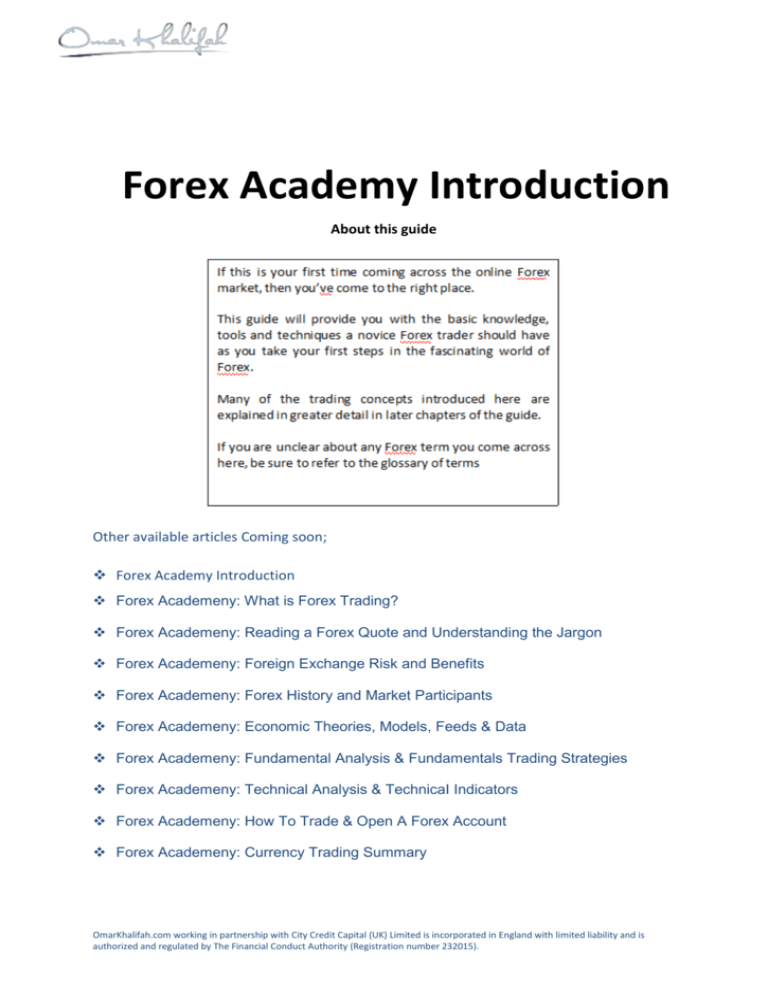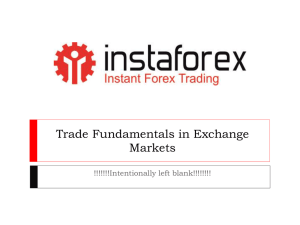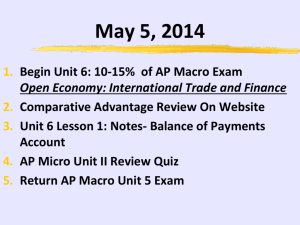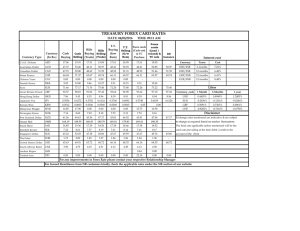Forex Academy Introduction
advertisement

Forex Academy Introduction About this guide Other available articles Coming soon; Forex Academy Introduction Forex Academeny: What is Forex Trading? Forex Academeny: Reading a Forex Quote and Understanding the Jargon Forex Academeny: Foreign Exchange Risk and Benefits Forex Academeny: Forex History and Market Participants Forex Academeny: Economic Theories, Models, Feeds & Data Forex Academeny: Fundamental Analysis & Fundamentals Trading Strategies Forex Academeny: Technical Analysis & TechnicaI Indicators Forex Academeny: How To Trade & Open A Forex Account Forex Academeny: Currency Trading Summary OmarKhalifah.com working in partnership with City Credit Capital (UK) Limited is incorporated in England with limited liability and is authorized and regulated by The Financial Conduct Authority (Registration number 232015). Intro: Why Forex? If you are reading this guide, you have most likely taken some sort of interest in the Forex market. But what does the Forex market have to offer you? Accessibility – It’s no wonder that the Forex market has the trading volume of 5 trillion a day ‐ all anyone needs to take part in the action is a computer with an internet connection. 24 Hour Market ‐ The Forex market is open 24 hours a day, so that you can be right there trading whenever you hear a financial scoop. No need to bite your fingernails waiting for the opening bell. Narrow Focus – Unlike the stock market, a smaller market with tens of thousands of stocks to choose from, the Forex market revolves around more or less eight major currencies. A narrow choice means no rooms for confusion, so even though the market is huge, it’s quite easy to get a clear picture of what’s happening. Liquidity ‐ The foreign exchange market is the largest financial market in the world with a daily turnover of just over $3 trillion! Now apart from being a really cool statistic, the sheer massive scope of the Forex market is also one of its biggest advantages. The enormous volume of daily trades makes it the most liquid market in the world, which basically means that under normal market conditions you can buy and sell currency as you please. You can never be in a jam for currency to buy or stuck with currency that you can’t unload. The Market Can’t Be Cornered ‐ The colossal size of the Forex market also makes sure that no one can corner the market. Even banks don’t have enough pull to really control the market for a long period of time, which makes it a great place for the little guy to make a move. Click here to open a free Practice account and join the Forex market today! OmarKhalifah.com working in partnership with City Credit Capital (UK) Limited is incorporated in England with limited liability and is authorized and regulated by The Financial Conduct Authority (Registration number 232015). Profitability It doesn’t take a financial genius to figure out that the biggest attraction of any market, or any financial venture for that matter, is the opportunity of profit. In the Forex market, profitability is expressed in a number of ways. First of all, just to set the record straight, you don’t have to be a millionaire to trade Forex. Unlike most financial markets, the Forex market allows you to start trading with relatively low initial capital. Right about now you’re probably asking yourself: “What chance do I have of profiting with such a low initial investment?” The Forex market doesn’t require large initial investments because it allows you to use leveraged trading. Leveraged trading lets you open positions for tens of thousands of dollars while investing sums as small as $1000. To trade $100,000 of currency, with a margin of 1%, an investor will only have to deposit $1,000 into his or her margin account. The leverage provided on a trade like this is 100:1. Leverage of this size is significantly larger than the 2:1 leverage commonly provided on equities and the 15:1 leverage provided by the futures market. Although 100:1 leverage may seem extremely risky, the risk is significantly less when you consider that currency prices usually change by less than 1% during intraday trading. If currencies fluctuated as much as equities, brokers would not be able to provide as much leverage. What is also unique about the Forex market is that any sort of movement is an opportunity to trade. Whether a currency is crashing or soaring, there is always room for speculation, since you always have the option of buying or selling the currency of your choice. Unlike the stock market, you are not limited to speculating on rising stocks, and a falling market is just as good for business as a rising market. Having said all that, it is important to remember that as profitable as the Forex market is, it still carries all the risks involved with financial trading. You should always be aware of the risk, and never risk money that you can’t afford to lose. Having said all that, it is important to remember that as profitable as the Forex market is, it still carries all the risks involved with financial trading. You should always be aware of the risk, and never risk money that you can’t afford to lose. OmarKhalifah.com working in partnership with City Credit Capital (UK) Limited is incorporated in England with limited liability and is authorized and regulated by The Financial Conduct Authority (Registration number 232015). Cashing in on Price Movements Trading Forex is exciting business. The market is always on the move, and every tiny shift in currency rates can mean profits and losses of hundreds and even thousands of dollars! Let’s demonstrate how that can happen: In general, the eight most traded currencies on the Forex market are: USD U.S. Dollar EUR - Euro GBP - British Pound JPY - Japanese Yen CAD - Canadian Dollar CHF - Swiss Franc NZD - New Zealand Dollar AUD - Australian Dollar Forex trading is always done in pairs, since any trade involves the simultaneous buying of a currency and selling of another currency. The trading revolves around EUR/USD EUR/CHF USD/CHF CHF/JPY GBP/USD GBP/CHF EUR/GBP EUR/CAD NZD/USD USD/JPY GBP/JPY AUD/NZD AUD/USD AUD/JPY AUD/CAD EUR/AUD When buying or selling a currency pair, each pair has its own Bid/Ask rate, for example: EUR/USD 1.5420 This means you could either: Buy the pair at the Ask rate Buy 1EUR / Sell $1.5422 Sell the pair at the Bid rate Sell 1 EUR / Buy $1.5420 OmarKhalifah.com working in partnership with City Credit Capital (UK) Limited is incorporated in England with limited liability and is authorized and regulated by The Financial Conduct Authority (Registration number 232015). The Trend is Your Friend Trend analysis is based on the idea that what has happened in the past gives traders an idea of what will happen in the future. Although this may seem pretty basic, being able to identify when a pair is in a trend and when it isn't will help you to increase your chances to profit consistently in the Forex market. When you can identify a trend, you can estimate what direction the rate of a currency pair is going to go in. You should exploit the direction of the trend you identify by placing a trade in that direction. If it’s an uptrend, meaning that the rate is increasing, buying the currency pair will give you a better probability for profit. If it’s a downtrend, meaning that the rate is decreasing, selling the currency pair will give you a better chance of making money. How do I identify a trend? What are the characteristics of a trend? The simplest way to identify a trend is through the distinct patterns that the price forms. These can tell you if the market is moving in an uptrend or downtrend. Identifying a Forex Trend When a trend is taking place in a Forex pair, the price movements start to form peaks and valleys in the chart of that pair, which are easily identified. In an uptrend, the price movements form a series of higher peaks and higher valleys. (Higher Highs and Higher Lows.) Since a picture’s worth a thousand words, lets look at the following chart: This chart suggests that the trader should buy the currency pair (and close the trade by selling at profit after the rate rises) OmarKhalifah.com working in partnership with City Credit Capital (UK) Limited is incorporated in England with limited liability and is authorized and regulated by The Financial Conduct Authority (Registration number 232015). In a down trend, the price movements form a series of lower peaks and lower Valleys (Lower Highs and Lower Lows) This chart suggests that the trader should sell the currency pair (and close the trade by buying at profit after the rate declines) It’s important to note that during some trading days the trend is hard to spot, some trading days show no trend (the price movements form a Range), and of course you’re bound to run into the occasional reversal, so this is not a perfectly accurate or 100% reliable indicator for trading. Here is what a trading Range looks like: It is easier to make predictions within a trend than with a trading range. While you can still profit in trading ranges, you have to be more nimble on your feet, and ready to jump in and out of the markets at all times. Needless to say, this makes the trader’s life a lot tougher and the risk for loss greater. Trading ranges can be really messy and unpredictable, which is why you should always look for trading trends. It’s a good idea to stay out all together during a range, and get back in only when the markets start to trend again. As a general strategy, it is best to trade with the OmarKhalifah.com working in partnership with City Credit Capital (UK) Limited is incorporated in England with limited liability and is authorized and regulated by The Financial Conduct Authority (Registration number 232015). trend rather than against it, meaning that if the general trend of the market is headed up, you should be very cautious about taking any positions that rely on the trend going in the opposite direction. The trend spotting strategy assumes that the present direction of the price rate will continue into the future. It can be used in three main time‐frames: short, intermediate and long‐term, with the trends being different for each. For example, here’s a possible scenario in the Forex market: Over the last 12 months the trend for the EUR/USD is an uptrend, over the last 30 days the trend is a downtrend, and over the last 24 Hours (intra‐day) trend is an uptrend. Regardless of the chosen time frame, traders will remain in their position until they believe the trend has reversed. So the goal is to spot a trend that you believe in and trade according to it. Needless to say, you will need to monitor the trade, in case you were mistaken and the trend vanishes or reverses. Then it's time to cut your losses by closing the losing trade or by reversing ‐ closing the trade and opening a following, opposite trade. Warning: Speculating on Forex rates involves great amount of risk. Be advised that even the most sophisticated traders can't always predict market movements' directions. Hedging Risks and Rewards Forex trading is a risky business. This chapter will explain the usage of Stop Loss (SL) and Take Profit (TP) orders. These are used for hedging your risks and rewards, realizing your profits and minimizing your losses. If the rate of your open trade drops below what’s covered by your investment, the trade is closed by the automatic Stop Loss. This means the maximum amount you can lose on a trade is almost always limited to the initial investment of the trade. Still, there is no reason why you should wait until you lose your entire investment to close the trade. By setting a Stop Loss order you make sure that the value of your trade doesn’t drop below a certain level. This way you control the maximum amount that you are willing to lose on a trade, without having to monitor each trade around the clock. Take Profit orders are similar to stop loss orders, only referring to profits. Take Profit orders make sure that once your trade reaches a certain level of profit it will be closed. OmarKhalifah.com working in partnership with City Credit Capital (UK) Limited is incorporated in England with limited liability and is authorized and regulated by The Financial Conduct Authority (Registration number 232015). For instance, imagine that you’ve opened a Long EUR/USD trade for at the rate of 1.5400. After a few hours the rate rises to 1.5500, but an hour later drops to 1.5300. Without a Take Profit order, you might miss the rise in the rate, and end up with a loss on your hands. If you had set a Take Profit order, the potential profit of the trade would have been realized, without you having to monitor the trade around the clock. Remember, Stop Loss and Take Profit orders are very simple tools that can make the difference between a successful trading career and a big hole in your pocket. Consider using these orders with every trade that you make. The Quest for Volatility The Forex market is open 24 hours a day, but what are the best times to make a profit? Even though the Forex market is open 24 hours a day with the exception of weekends, not all hours are as equally good for trading. The reason that the Forex market is open 24 hours a day is that it is made up of different sessions around the globe that between them cover 24 hours. The more markets are active at the same time, the more trades are being executed, and the more action for you to cash in on. OmarKhalifah.com working in partnership with City Credit Capital (UK) Limited is incorporated in England with limited liability and is authorized and regulated by The Financial Conduct Authority (Registration number 232015). Abuse the news. As for news reports, these are times to be careful. Many profitable trades are made moments prior to or shortly after major economical announcements. You can gain a fortune as well as lose one if you’re not sure of what you’re doing. This is why it’s important to stay on top of what’s happening in the international finance arena. Market sentiment becomes crucial at these times, since traders basically stampede to the market around the time of the report. Remember, even though you’re able to trade 24 hours a day, it’s better to plan your trading activity in order to catch the best action for a chance to maximize your profits and minimize your losses. Money Management Is there a secret to becoming a successful trader? There is a method that all successful traders use, and it’s no secret. It’s called money management. Money management is not some vague industry lingo – it simply means the knowledge and skill of managing your Forex trading account. As simple as that may seem, it’s the key to a long and successful trading career. And yet it is often forgotten or neglected in the thrill of the trade. We’d like to take this opportunity to lay out some ground rules by which you can effectively manage your account. Don’t go looking for the Big Win; it will most likely result in a big loss. Successful trading means consistent trading, where small wins amount to large long term profits. Never assume that all your trades will be profitable, and plan on losses. You should only risk a small percentage of your total account balance on each trade. This simply minimizes your risk, so that even if you end up losing your entire investment on a trade, it doesn’t have a critical effect on your account balance. The recommended amount is OmarKhalifah.com working in partnership with City Credit Capital (UK) Limited is incorporated in England with limited liability and is authorized and regulated by The Financial Conduct Authority (Registration number 232015). 1% of your total account balance per trade. More aggressive traders go as high as 5%, but never higher than that. It is a very important rule to keep, since the lower your account balance drops, the harder it is to rebuild it. Using Limit Orders Learn to use the Stop Loss and Take Profit orders effectively. These orders protect your investment and realize your profits. They are very simple tools that can make all the difference to your account balance. Size of Trades You are suggested to open small trades, because in the case of a losing trade, you can then open the opposite trade with a bigger investment or higher leverage, thus compensating for losses. Practice with Virtual Money Use virtual money mode for practice. Virtual money mode works exactly the same as real trading mode and uses the same real time rates, with the small difference of no risk involved. We recommend using the practice mode to get to know the platform and gain Forex trading experience. And even after you’ve begun trading with real money, it is the perfect place to try out your trading strategies. There is no point in risking your money to test out a possible theory, when you can do so with the same success minus the risk. After seeing that your strategy is consistently successful with virtual money, you can try it out for real. Remember, money management is very simple to master, but not as simple to keep up. Once you’ve developed the money management system that works for you, make sure to stick with it and don’t let your emotions get in the way of long term profit, even if it means absorbing short term losses. Now that you’re equipped for trading, take your time and start practicing your trading skills. Follow this link to open your free demo account today. OmarKhalifah.com working in partnership with City Credit Capital (UK) Limited is incorporated in England with limited liability and is authorized and regulated by The Financial Conduct Authority (Registration number 232015).




